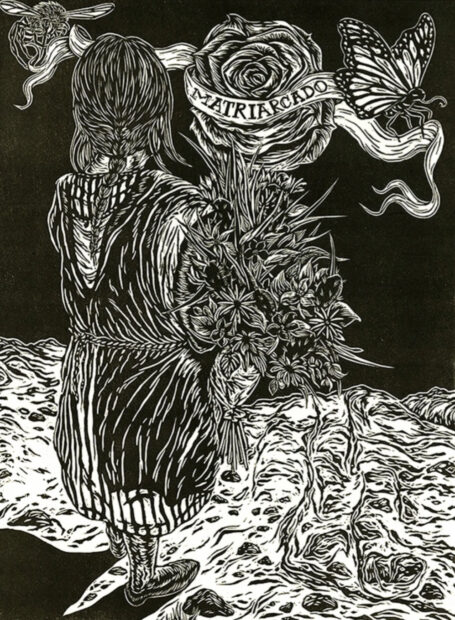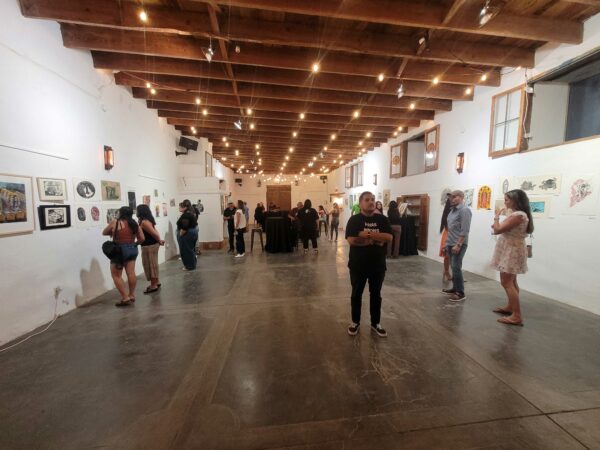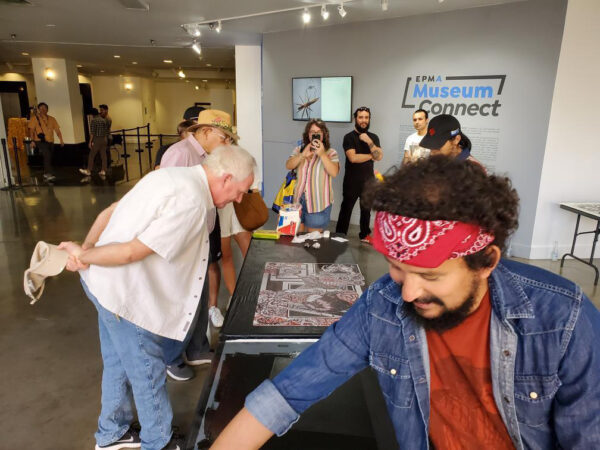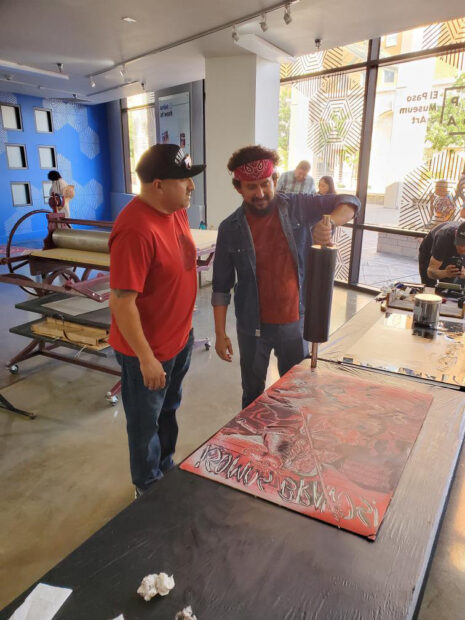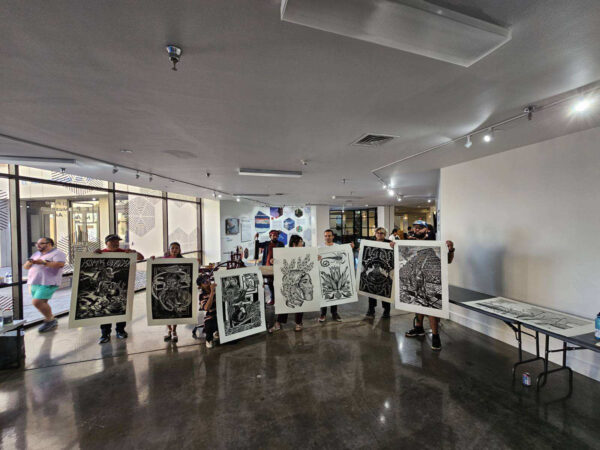Para leer este artículo en español, por favor vaya aquí. To read this article in Spanish, please go here.
Marco Sánchez is an El Paso, Texas-based printmaker, painter, artist, and curator. He received his BFA from the University of Texas at El Paso (UTEP) in Printmaking and Painting and his MFA in Printmaking from Edinboro University of Pennsylvania, now PennWest Edinboro. He has completed various printmaking residencies at Zygote Press in Cleveland, Ohio; Taller Gráfica Libre in Oaxaca, Mexico; and Casa Galeria Victor Lopez in Querétaro, Mexico, to name a few. He has also been an invited visiting artist at Gonzaga University and Kent State University.
His work has been shown internationally and he is the creative, logistics, and grant writing force behind the inaugural El Paso Print Pachanga (Pachanga is “party” in Spanish). The event consisted of a juried print exhibition, a linocut printmaking workshop, live printing, a vendor market, and events across El Paso, including the El Paso Museum of Art and the El Paso Museum of History.
Nicolas Silva (NS): Marco, I have known you since undergrad and your Instagram handle @onpaperandcanvas is very literal, as I knew you to be always working on prints and paintings. You are like an “energizer bunny” of artistic energy. Could you tell us about how you got started in the creative or artistic fields and what inspired you to pursue art as a career?
Marco Sánchez (MS): I started making art and pursuing a career in the arts at 27 years old — I’d say a little later than most. I did have an artistic presence in my life in the form of my grandfather, Guillermo Cordero Enriquez, who was a painter and printmaker in Michoacán, Mexico. I wasn’t really interested in art, nor did I ever imagine that being an artist could be something I would make my professional practice. That changed during a backpacking trip I took with my best friend in 2007. We started in Caracas, Venezuela and traveled back north to El Paso, doing so only by land and sea. It was during this trip that we made a stop in Zirahuén, Michoacán, and spent some days with my grandfather. I hadn’t seen his studio or him actively working on a painting since I was five years old, when he moved from Juárez to Zirahuén. It ignited a curiosity in me to grab a paint brush and start messing around on canvas.
NS: Could you describe your training at UTEP, including the intricacies of UTEP’s print program in comparison to other spaces you have trained or worked at? I remember you extensively training with Francisco Delgado, Kim Bauer, Suzi Davidoff, and other UTEP faculty. Are there any other people that have helped shape your artistic visions and practice over the years?
MS: I always enjoyed my time at UTEP and sometimes we can undervalue the spaces we inhabit at the time, but I did always value and appreciate my faculty and their dedication to their students. You pointed out that I studied under Francisco Delgado and Kim Bauer, and I always place both of them as my highest motivators right alongside my grandfather. I really appreciated Delgado’s ideologies as a Mexican, Chicano, Chuqueño artist, and saw a correlation between my life experience and his. I always aspired to be a mentor for other young brown artists like Francisco was to me.
I appreciated and marveled at Kim Bauer’s knowledge of the various printmaking methodologies and the effortlessness in his elucidation of them in such an unassuming way so that students could understand all the complicated techniques and materiality. Bauer’s vivacious teaching approach and demeanor in the studio made it easy to want to be there and created an atmosphere that promoted a healthy and friendly competition. I have to also say that from all the print studios I have been fortunate to make work in, the UTEP studios have still been my favorite and I find myself daydreaming of that space from time to time.
I must admit that the printmakers who I looked at for influence the most are masters of Mexican printmaking; Leopoldo Méndez, Alfredo Zalce, Mariana Yampolsky, and José Clemente Orozco; but also the likes of Käthe Kollwitz and Elizabeth Catlett.
NS: El Paso has great artists like your print mentor and colleague, the Yale-MFA-trained Francisco Delgado, his daughter Citlali, Christin Apodaca, Jesus “CIMI” Alvarado of Kalavera Culture Shop, Manny Guerra of Horned Toad Prints, and others. Do you think printmaking in El Paso and beyond needs more diversity? Is the Pachanga addressing this by offering classes and education opportunities, like the drypoint workshop at the El Paso History Museum? Do you think we will see more women and underrepresented voices in the medium?
MS: We do have some great talent here in El Paso, and I will add Staphany Garnica as one of my favorite local artists to that list. I do think there is a push not only in El Paso but around the print world in general for diversity and inclusivity. That is something I strive for in my practice as an educator and in the curation I have been doing as of late. To me, it was important to have a good balance of artists across genders during the El Paso Print Pachanga. Adrianne Ramirez was hired to give the drypoint workshop, and was an easy and clear choice. She is a recent UTEP graduate, whose work is outstanding. There is always that strange and uncomfortable “in between” stage when you’re fresh out of academia; I figured this might help prevent that, and she can continue with her practice.
NS: Please give us the nitty-gritty details of the El Paso Print Pachanga from ideation to curation, to grant writing, to execution.
MS: I think there were two main factors to making the Print Pachanga happen. The first came from my traveling and working in Mexico. It’s bewildering to me that in gorgeous small towns, like Pátzcuaro, Michoacán, which has a population of less than 100,000 people, there are seven active fine art printmaking studios. El Paso only has Horned Toad Prints and Taller La Espina. The other factor was that I travel to various places in the U.S. to be part of print fairs and conferences. Some of those are the Southern Graphics Council International and Mid American Print Council, which change cities yearly, to the Southwest Print Fiesta in Silver City, Print Austin, and Grabadolandia in Chicago.
All this is to say that we need to place more importance on cultural events, and the border is such an important place for commerce, historically and politically. There’s so much talent here that is overlooked. I had the opportunity to study in the Northeastern part of the United States, and I must say that El Paso has some incredibly talented artists with incredible narratives and studio explorations. It was important to make sure local, regional artists and those who came to the Print Pachanga from out of town experienced and recognized that.
NS: What do you think artists and supporters need to do to sustain artistic excellence and careers here on the border and beyond?
MS: It’s great to see new faces in the art scene here in El Paso, and that is a tricky question. It’s a conversation I’ve had with other artists, collectors, and friends. It can be difficult to be a working artist in a city where events by local and regional artists aren’t as supported as much as we would like at times. I think having collective art spaces definitely helps; sometimes working artists need the space to work and the space to exhibit work. The ones that are focused and serious about their artistic practice will always find a way to continue. That being said, we also need to diversify and figure out a way to reach a broader audience — it seems it’s always the same group of people or friends who come out to local art events.
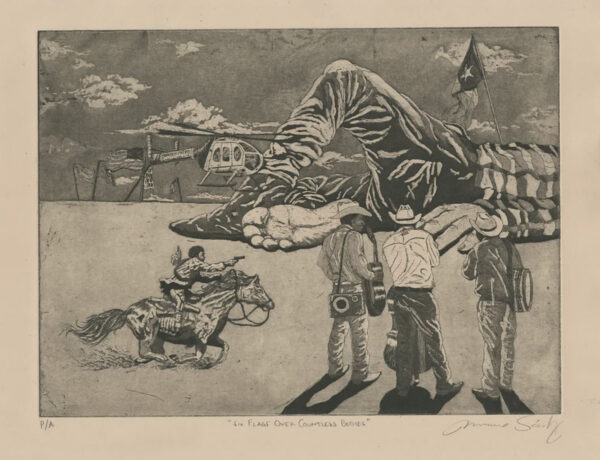
Marco Sánchez, “Six Flags Over Countless Bodies”, 2019, etching with aquatint, 15 x 11 inches. Image courtesy of the artist.
NS: What are some of your favorite artistic memories of your life, from struggles in grad school to shows or experiences that have taken your breath away?
MS: I have a few. The first is having my first solo show out of academia at Agave Rosa Gallery in central El Paso. I asked the gallery owner if she’d let me invite a guest artist, she said yes when I mentioned that artist would be my grandfather, and it was my first time exhibiting work alongside him. Other favorite moments are recent ones: being selected to exhibit with great Texas-based artists in Soy de Tejas, organized by Print Pachanga juror, artist, gallerist, and all-around chingón Rigo Luna, co-owner of Presa House Gallery in San Antonio.
I also organized an international print portfolio titled Nexo Entre Raíces, composed of 33 Mexican, Mexican-American or Chicanx-identifying artists, 16 of whom are based in Mexico and 17 of whom are based in the U.S. This portfolio has already traveled to Kent State University and to the National Hispanic Cultural Center in Albuquerque. It will also be on display at the BUAP in Puebla, Mexico. We are slated to show it at the El Paso Museum of Art, opening in March of 2024, and we’re also booked for the Janet Turner Print Museum in Chico, California in 2025. Of course, the El Paso Print Pachanga has to be on that list — it took so much time and effort, and I think we did a good job, but we can always do better now that we got our feet wet with organizing the first event.
NS: I would like to thank supporters like the National Endowment of the Arts and Museums and Cultural Affairs Department for supporting amazing work like yours and the Print Pachanga, which keeps us alive and thriving. I especially want to thank foundations, private institutions, and individuals that keep the arts going in El Paso. With this said, do you have any future visions for the Pachanga and your artistic practice, whether individual, collaborative, academic, etc. that you would like to share?
MS: I would also like to extend my gratitude to everyone you just mentioned. It means the world for artists to have support and trust from such organizations, as well as those who attended. I do have some plans and hope I can make them happen, with the continued support of MCAD and the NEA, of course. I would like to bring in a handful of artists from Mexico and elsewhere to give workshops, talks, and smaller group exhibitions. I also want to partner with both UTEP and El Paso Community College students, since there wasn’t a big turnout from them this time around. I definitely want to highlight their work.
NS: Lastly, I know that outside of your work there isn’t much downtime, but what have you been doing outside of printmaking? Any traveling, reading, hobbies, or leisure?
MS: I’ve always loved to travel, cook, and try different cuisines, so I’ll continue to do that. Sports have always been a big part of my life, however being an educator and artist has left little time for me to practice much, so I’d like to take some time and get back to snowboarding during the season. Honestly, I just want to spend time with friends and family as well, I need to remind myself to slow down from time to time.
NS: Anything else you would like to add?
MS: Yes, firstly, I want to thank you for always being such a devoted supporter of the arts! For those who missed the first Print Pachanga, we expect you to come out to the next one and keep an eye out for future projects or workshops by Taller La Espina and friends of the Printshop.
Nico Silva is a PhD student in Interdisciplinary Health Sciences, a licensed master social worker, an artist, a writer, and a Society for Neuroscience Neuroscience Scholar Program (NSP) Associate. He envisions a future where the arts and artists are supported to their full potential.


